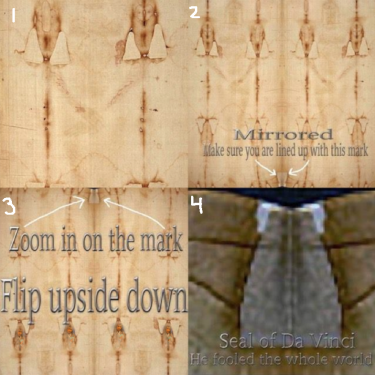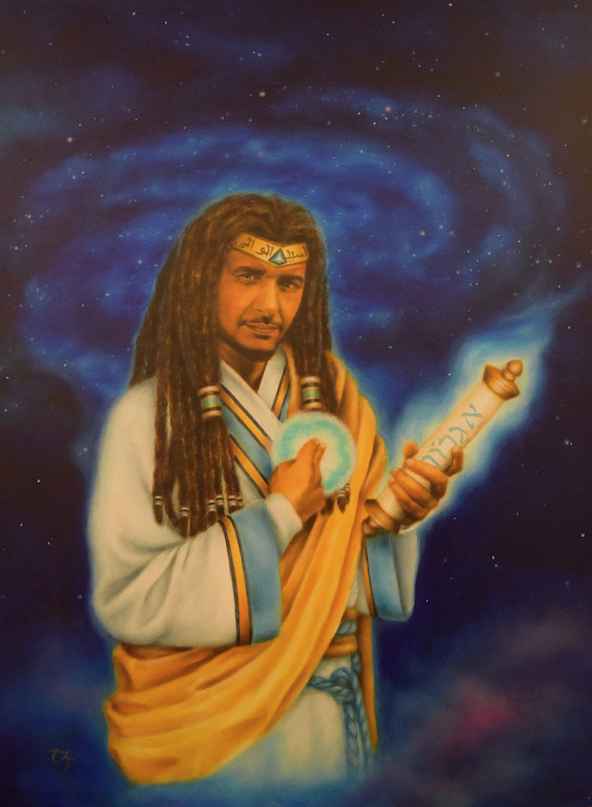Seal of Da Vinci Found On The Shroud Of Turin


Da Vinci Seal: In gold Facing You. In White Da Vinci Mirrored himself.
GLOBAL NEWS CENTRE
The Black Prophet Confirms: Shroud of Turin WORK OF DA VINCI
GAME OVER! -ACE KNIGHT
Leonardo Da Vinci was a leading artist and intellectual of the Italian Renaissance who’s known for his enduring works “The Last Supper” and “Mona Lisa.”
Florentine court records show that in 1476 da Vinci and four other young men were charged with sodomy, a crime punishable by exile or even death. Although da Vinci was acquitted, his whereabouts went entirely undocumented for the following two years.
“Renaissance Man” Emerges in Milan
After leaving Verrocchio’s studio, da Vinci received his first independent commission in 1478 for an altarpiece to reside in a chapel inside Florence’s Palazzo Vecchio. Three years later the Augustinian monks of Florence’s San Donato a Scopeto tasked him to paint “Adoration of the Magi.” The young artist, however, would leave the city and abandon both commissions without ever completing them.
In 1482, Florentine ruler Lorenzo de’ Medici commissioned da Vinci to create a silver lyre and bring it as a peace gesture to Ludovico Sforza, who ruled Milan as its regent. After doing so, da Vinci lobbied Ludovico for a job and sent the future Duke of Milan a letter that barely mentioned his considerable talents as an artist and instead touted his more marketable skills as a military engineer. Using his inventive mind, da Vinci sketched war machines such as a war chariot with scythe blades mounted on the sides, an armored tank propelled by two men cranking a shaft and even an enormous crossbow that required a small army of men to operate. The letter worked, and Ludovico brought da Vinci to Milan for a tenure that would last 17 years.
His ability to be employed by the Sforza clan as an architecture and military engineering advisor as well as a painter and sculptor spoke to da Vinci’s keen intellect and curiosity about a wide variety of subjects. Like many leaders of Renaissance humanism, da Vinci did not see a divide between science and art. He viewed the two as intertwined disciplines rather than separate ones. He believed studying science made him a better artist.
Leonardo thought sight was humankind’s most important sense and eyes the most important organ. He stressed the importance of saper vedere, “knowing how to see.” He believed in the accumulation of direct knowledge and facts through observation.
“A good painter has two chief objects to paint—man and the intention of his soul,” da Vinci wrote. “The former is easy, the latter hard, for it must be expressed by gestures and the movement of the limbs.” To more accurately depict those gestures and movements, da Vinci began to seriously study anatomy and dissect human and animal bodies during the 1480s. His drawings of a fetus in utero, the heart and vascular system, sex organs and other bone and muscular structures are some of the first on human record.
In addition to his anatomical investigations, da Vinci studied botany, geology, zoology, hydraulics, aeronautics and physics. He sketched his observations on loose sheets of papers and pads that he tucked inside his belt. He placed the papers in notebooks and arranged them around four broad themes—painting, architecture, mechanics and human anatomy. He filled dozens of notebooks with finely drawn illustrations and scientific observations. His ideas were mainly theoretical explanations, laid out in exacting detail, but they were rarely experimental.
Art and science intersected perfectly in his sketch of “Vitruvian Man,” which depicted a male figure in two superimposed positions with his arms and legs apart inside both a square and a circle. A man ahead of his time, da Vinci appeared to prophesize the future with his sketches of machines resembling a bicycle, helicopter and a flying machine based on the physiology of a bat.
‘The Last Supper’ and Other Works
Leonardo was commissioned to work on numerous projects during his time in Milan. His painting of the “Virgin of the Rocks,” begun in 1483, demonstrated his pioneering use of chiaroscuro—a stark contrast between darkness and light that gave a three-dimensionality to his figures—and sfumato—a technique in which subtle gradations, rather than strict borders, infuse paintings with a softer, smoky aura.
Around 1495, Ludovico commissioned da Vinci to paint “The Last Supper” on the back wall of the dining hall inside the monastery of Milan’s Santa Maria delle Grazie. The masterpiece, which took approximately three years to complete, captures the drama of the moment when Jesus informs the Twelve Apostles gathered for Passover dinner that one of them would soon betray him. The range of facial expressions and the body language of the figures around the table bring the masterful composition to life. The decision by da Vinci to paint with tempera and oil on dried plaster instead of painting a fresco on fresh plaster led to the quick deterioration and flaking of “The Last Supper.” Although an improper restoration caused further damage to the mural, it has now been stabilized using modern conservation techniques.
In addition to having da Vinci assist him with pageants and designing a dome for Milan’s cathedral, the Duke of Milan tasked the artist with sculpting a 16-foot-tall bronze equestrian statue of his father and founder of the family dynasty, Francesco Sforza. With the help of apprentices and students in his workshop, da Vinci worked on the project on and off for more than a dozen years. Leonardo sculpted a life-size clay model of the statue, but the project was put on hold when war with France required bronze to be used for casting cannons, not sculptures. After French forces overran Milan in 1499—and shot the clay model to pieces—da Vinci fled the city along with the duke and the Sforza family.
Return to Florence and “Mona Lisa”
After brief stays in Mantua and Venice, da Vinci returned to Florence. In 1502 and 1503, he briefly worked as a military engineer for Cesare Borgia, the illegitimate son of Pope Alexander VI and commander of the papal army. He traveled outside of Florence to survey military construction projects and sketch city plans and topographical maps. He designed plans, possibly with noted diplomat Niccolò Machiavelli, to divert the Arno River away from rival Pisa in order to deny its wartime enemy access to the sea.
Upon his return to Florence in 1503, da Vinci started work on the “Battle of Anghiari,” a mural commissioned for the council hall in the Palazzo Vecchio that was to be twice as large as “The Last Supper.” However, he abandoned the project after two years when the mural began to deteriorate before he had a chance to finish it.
At the same time he began the “Battle of Anghiari,” da Vinci started working in 1503 on what would become his most well known painting—and arguably the most famous painting in the world—the “Mona Lisa.” The privately commissioned work is characterized by the enigmatic smile of the woman in the half-portrait, which derives from da Vinci’s sfumato technique.
Adding to the allure of the “Mona Lisa” is the mystery surrounding the identity of the subject. Princess Isabella of Naples, an unnamed courtesan and da Vinci’s own mother have been put forth as potential sitters for the masterpiece. It has even been speculated that the subject wasn’t a female at all but da Vinci’s longtime apprentice Salai dressed in women’s clothing. Based on accounts from an early biographer, however, the “Mona Lisa” is a picture of Lisa del Giocondo, the wife of a wealthy Florentine silk merchant. The painting’s original Italian name—“La Gioconda”—supports the theory, but it’s far from certain. Some art historians believe the merchant commissioned the portrait to celebrate the pending birth of the couple’s next child, which means the subject could have been pregnant at the time of the painting.
If the Giocondo family did indeed commission the painting, they never received it. For da Vinci, the “Mona Lisa” was forever a work in progress, as it was his attempt at perfection. Leonardo never parted with the painting. Today, the “Mona Lisa” hangs in the Louvre Museum in Paris, France, secured behind bulletproof glass and regarded as a priceless national treasure seen by millions of visitors each year.
Final Years
Leonardo returned to Milan in 1506 to work for the very French rulers who had overtaken the city seven years earlier and forced him to flee. Among the students who joined his studio was young Milanese aristocrat Francesco Melzi, who would become da Vinci’s closest companion for the rest of his life. He did little painting during his second stint in Milan, however, and most of his time was instead dedicated to scientific studies.
Ironically, Gian Giacomo Trivulzio, who had led the French forces who conquered Ludovico in 1499, followed in his foe’s footsteps and commissioned da Vinci to sculpt a grand equestrian statue, one that could be mounted on his tomb. After years of work and numerous sketches by da Vinci, Trivulzio decided to scale back the size of the statue, which was ultimately never finished.
Amid political strife and the temporary expulsion of the French from Milan, da Vinci left the city and moved to Rome in 1513 along with Salai, Melzi and two studio assistants. Giuliano de’ Medici, brother of newly installed Pope Leo X and son of his former patron, gave da Vinci a monthly stipend along with a suite of rooms at his residence inside the Vatican. His new patron, however, also gave da Vinci little work. Lacking large commissions, he devoted most of his time in Rome to mathematical studies and scientific exploration.
After being present at a 1515 meeting between France’s King Francis I and Pope Leo X in Bologna, the new French monarch offered da Vinci the title “Premier Painter and Engineer and Architect to the King.” Along with Melzi, the Tuscan native departed for France, never to return. He lived in the Chateau de Cloux (now Clos Luce) near the king’s summer palace along the Loire River in Amboise. As in Rome, da Vinci did little painting during his time in France. One of his last commissioned works was a mechanical lion that could walk and open its chest to reveal a bouquet of lilies. He continued work on his scientific studies until his death at the age of 67 on May 2, 1519. Da Vinci’s assistant, Melzi, became the principal heir and executor of his estate. The “Mona Lisa” was bequeathed to Salai.
Although da Vinci is known for his artistic abilities, fewer than two-dozen paintings attributed to him exist. One reason is that his interests were so varied that he wasn’t a prolific painter. For centuries afterward, however, thousands of pages from his private journals with notes, drawings, observations and scientific theories have surfaced and provided a fuller measure of a true “Renaissance man.”



















 London
London
 Oregon
Oregon





Leave a Reply
You must be logged in to post a comment.